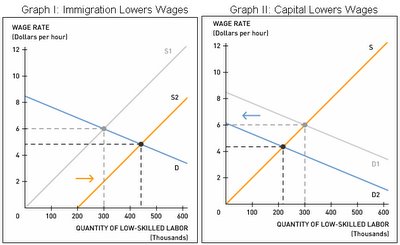Quality, Choice, and Growth
by Chris Makler Two articles in the New York Times this week are nicely complementary. Each looks at long-term trends in the U.S. economy, and in particular what Americans have chosen to spend their money on as they became progressively richer over the past few generations. And each argues that quality improvements have been a major force in driving American consumption patterns.
Two articles in the New York Times this week are nicely complementary. Each looks at long-term trends in the U.S. economy, and in particular what Americans have chosen to spend their money on as they became progressively richer over the past few generations. And each argues that quality improvements have been a major force in driving American consumption patterns. In the first, David Leonhardt argues that Americans face a tradeoff between better health care and other consumption goods. While he states that the health care system is indeed in crisis, he doesn't worry that increases in health care spending outpace inflation. We get what we pay for, in his view; and although Americans now pay, on average, $5,500 more per year on health care than they did in the 1950's, that's a small price to pay for the increased quality of life we now enjoy.
Robert Frank makes a similar point in an article titled "The More We Make, the Better We Want." He points out that we could now afford the lifestyles of our grandparents with only a fraction of our current income, but we choose not to.
Both articles illustrate a central element that drives economic growth: the insatiability of human desires. When Adam Smith wrote The Wealth of Nations, it was an easy argument to suggest that scarcity is a defining principle of life -- for one thing, just getting enough calories to survive was a challenge for a majority of people. But in an era when obesity is a bigger problem for Americans than hunger, it's reasonable to ask why we continue to work so hard. In the words of Keynes (that Frank quotes), "A point may soon be reached, much sooner perhaps than we are all aware of, when these needs are satisfied in the sense that we prefer to devote our further energies to noneconomic purposes." Clearly that point has come and gone, and yet here I am at work. Why?
Frank argues that the answer to this question lies in the understanding of what "basic needs" are. A theme running through much of his work is that people define their needs in relative terms, rather than absolute terms. Thus everyone might want a "good house in a safe neighborhood," but that might mean something very different in Los Angeles than it means in Baghdad. If the rest of society is driving a Camry, then, almost nobody is going to be happy driving a Model T.
Leonhardt argues that the answer to this question lies in the fact that technology--and in particular, medical technology--extends the boundary of what is possible. Living a healthy, full life means something very different in 2006 than it did in 1950, but taking advantage of modern medicine costs money.
1. Suppose you're in the market for a car, and you know that you want something like a Honda Civic. You come upon a brand new 1980 Honda Civic that had never been driven. You could save a lot of money by buying that car rather than a 2006 Civic. You work an hourly job and can choose how many hours you work. Suppose that if you bought a 2006 Civic and worked for 40 hours a week, you could afford to spend $400 per week on other goods. If you bought the 1980 Civic, you could either choose to still spend $400 on other goods and work fewer hours, or you could continue to work a full 40-hour week and spend more than $400 on other goods. Which of these options would you choose?
2. Suppose you meet a genie who offers you a choice: you can live in the 1950's and earn more than 90% of people, or live in the present and earn the average wage. Which would you choose? What if it were the year 1900? Or 1500? (Before you answer, you might want to pause and think a moment about indoor plumbing.)
3. Suppose a medical research project could extend life expectancy from 80 to 100 years. How much should we, as a society, be willing to pay for that project? What about one that extended life expectancy to 120 years? Or 140? Perhaps an easier question to answer might be: how much would you be willing to pay to extend your own life expectancy? What current consumption would you give up to live an additional year?
Labels: Economic Growth, Preferences, Real Wages, Tradeoffs




